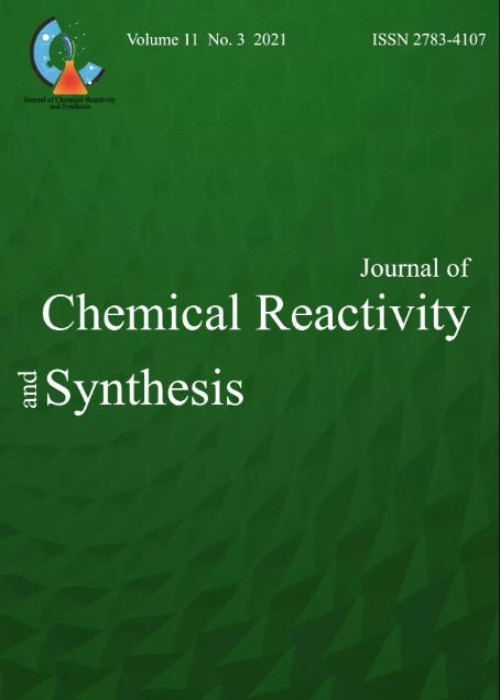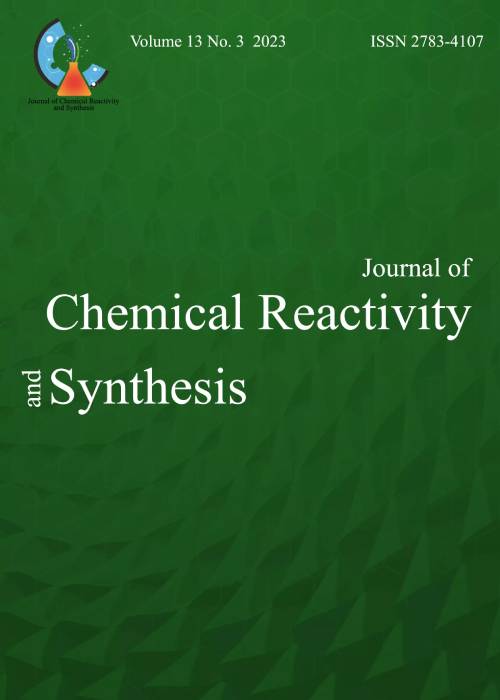فهرست مطالب

Journal of Chemical Reactivity and Synthesis
Volume:11 Issue: 3, Summer 2021
- تاریخ انتشار: 1400/05/10
- تعداد عناوین: 6
-
Pages 118-126In the present study, NiO–NPs have been synthesized via the green method and using Eucalyptus leaf extract as a reducing and limiting agent. The morphology and structure of the NiO–NPs have been investigated via FE-SEM, FTIR, XRD, and EDX/ MAP. The results of the achieved XRD and FT-IR analyses have confirmed the formation of pure and crystalline NiO–NPs. The results showed that NiO nanostructures with smaller crystal sizes are formed using lower calcination temperatures.Keywords: Green synthesis, Nickel oxide, nanoparticles, Eucalyptus leaf extract
-
Pages 127-150The octyl-β-D-xyloside is a biosurfactant with well-known roles in membrane protein systems. Using an efficient delivery system for these biosurfactants is of primary importance. This paper investigates the potential application of Al12N12 and B12N12 nanocages as an electronic sensor for octyl-β-D-xyloside surfactant detection in the gas phase using density functional theory calculations. Our results show that the electronic properties of Al12N12 and B12N12 nanocages were significantly affected by the adsorption of the octyl-β-D-xyloside molecule. The adsorption energies and enthalpies predicted a thermodynamically favorable chemisorption process. The AIM analysis reveals the formation of normal and bifurcated hydrogen bonds for Al12N12 and B12N12 nanocages whilst, for O3, O2, and O4 positions we identify the inter/intra-molecular hydrogen bonds. The NBO results revealed a charge transfer from the adsorbed octyl-β-D-xyloside molecule to the nanocluster. Our finding revealed although both Al12N12 and B12N12 nanocages have the ability to detect and adsorb the octyl-β-D-xyloside but, the adsorption over the Al12N12 is not favorable due to the high recovery time. Whilst, the adsorption of the octyl-β-D-xyloside through O3 with less steric factor on the B12N12 nanocage and the recovery time of S, is the best adsorption site.Keywords: DFT, Octyl-β-D-xyloside, Al12N12, B12N12, Nanocage, Adsorption, sensor
-
Pages 151-169In the present project, Fe3O4 nanoparticles were prepared from the co-precipitation reaction of Feц , Feш in ammonia medium. The obtained nanoparticles were used as a substrate to stabilize polyethylene glycol. To stabilize PEG on Fe3O4 surface, Fe3O4 hydroxy groups and PEG hydroxy group reacted in the presence of HCL. The resulting nanocomposite was structured by FT-IR spectroscopy and its morphology was examined by SEM. Nanocomposite was used as an effective catalyst for four-component compaction between ammonium acetate, ethyl acetate, dimidone and aromatic aldehyde under solvent-free conditions. Polyhydroquinoline products were prepared in low times and with high efficiencies.
-
Pages 170-175Thiourea derivatives are an important group of chemical compounds that play important roles in agriculture, pharmaceuticals, pesticides, and plant growth regulators. Herein a fast synthesis of 1, 3-diaryl-thiourea derivatives by one-pot multi-component reaction of 2-amino-benzoic acid, aryl isothiocyanate, isocyanide, and carbonyl under solvent free condition using Cu(II)-Schiff base/SBA-15 as a reusable heterogeneous catalyst in high yields was reported. These kinds of catalysts are built from mesoporous silica SBA-15 which was covalently anchored with Cu(II) Schiff base complex. The shorter reaction times, good yields, simple work-up procedure and environmentally friendly conditions are the main advantages of this method compared to the last one. This method is also the first example of synthesizing 1, 3-diaryl-thiourea derivatives by Cu(II)-Schiff base/SBA-15 as an efficient catalyst in solvent-free media which can be valuable to be used or investigated for similar systems. The product was identified by its 1H NMR, Mass and IR spectra, which were compared to those reported previously.
-
Pages 176-194Caspian Tamin Pharmaceutical Company strives to produce and process injectable and non-injectable pharmaceutical products, including ampoules, ointments, gel creams, suppositories, oral solutions in the form of syrups. Have high sensitivity) is also done carefully. Therefore, the higher the experiences and knowledge of the relevant personnel and the accuracy of the device and its efficiency (producing more product and better quality, in less time, leads to a more favorable production result). All processes in this factory are following GMP and WHO rules. The goal of Caspian Tamin Pharmaceutical Company is to produce pharmaceutical products with a focus on injectable products to promote community health. On the other hand, Caspian Tamin Pharmaceutical Company aims to supply and provide a large number of low-volume injectable drugs. These and other details have been studied in detail in this paper.Keywords: Process, production, Control, Pharmaceutical Company
-
Pages 195-201MgBr2·Et2O as an available and inexpensive catalyst is used for the synthesis of quinoxalines by a wide range of different o-phenylenediamines and α-diketones at room temperature. Using this strategy, quinoxaline derivatives as biologically interesting compounds are produced in good yields, short reaction times, simple isolation and mild conditions.Keywords: MgBr2•Et2O, o-Phenylenediamines, α-Diketones, Benzopyrazine


